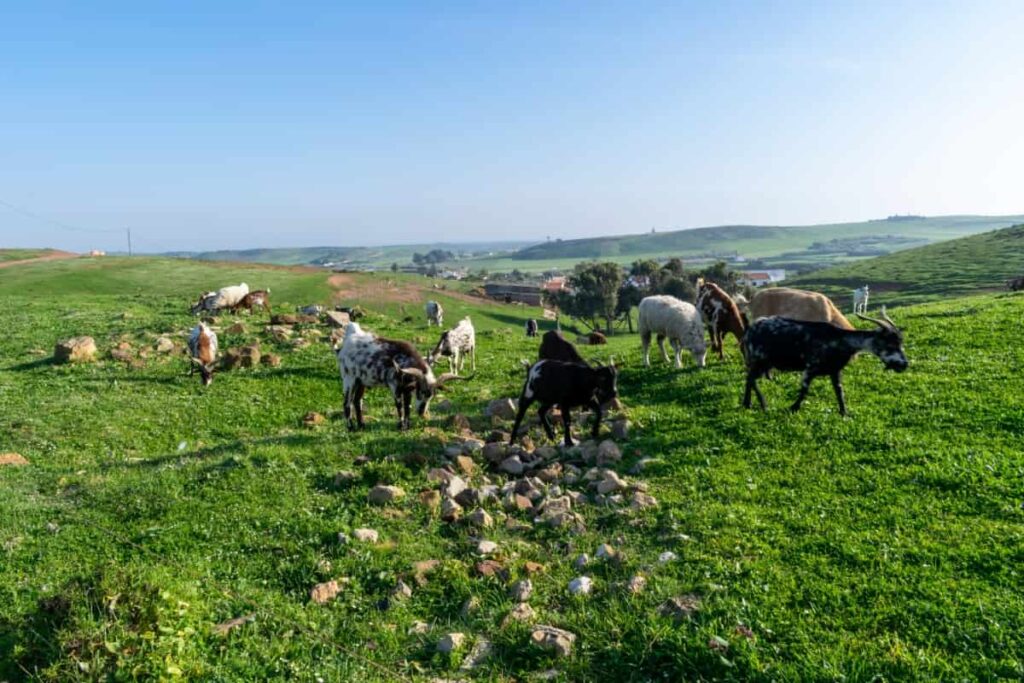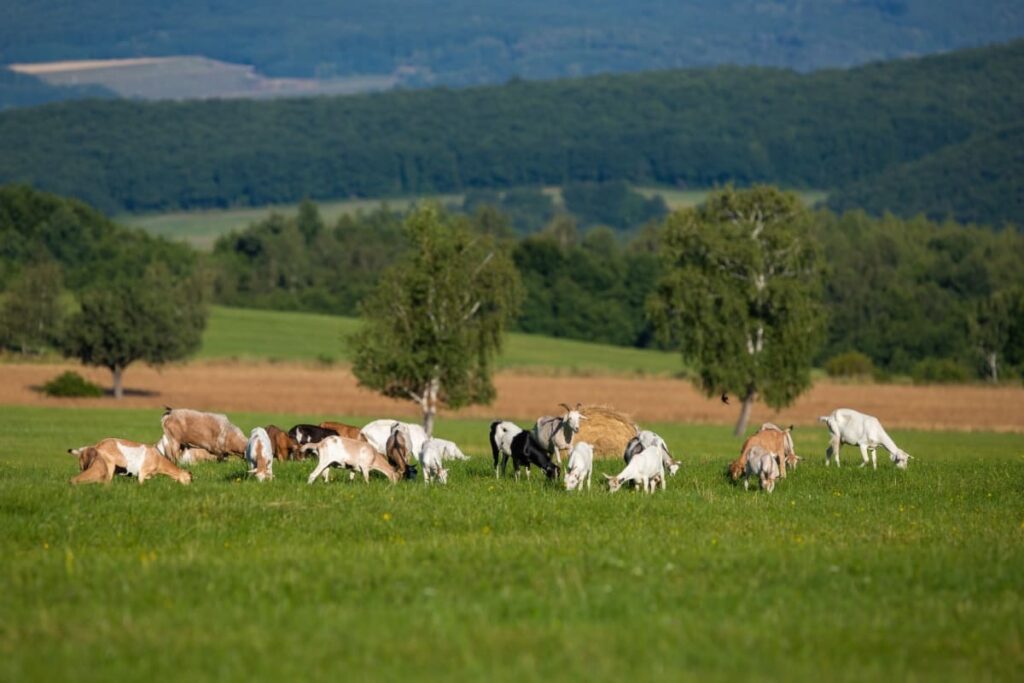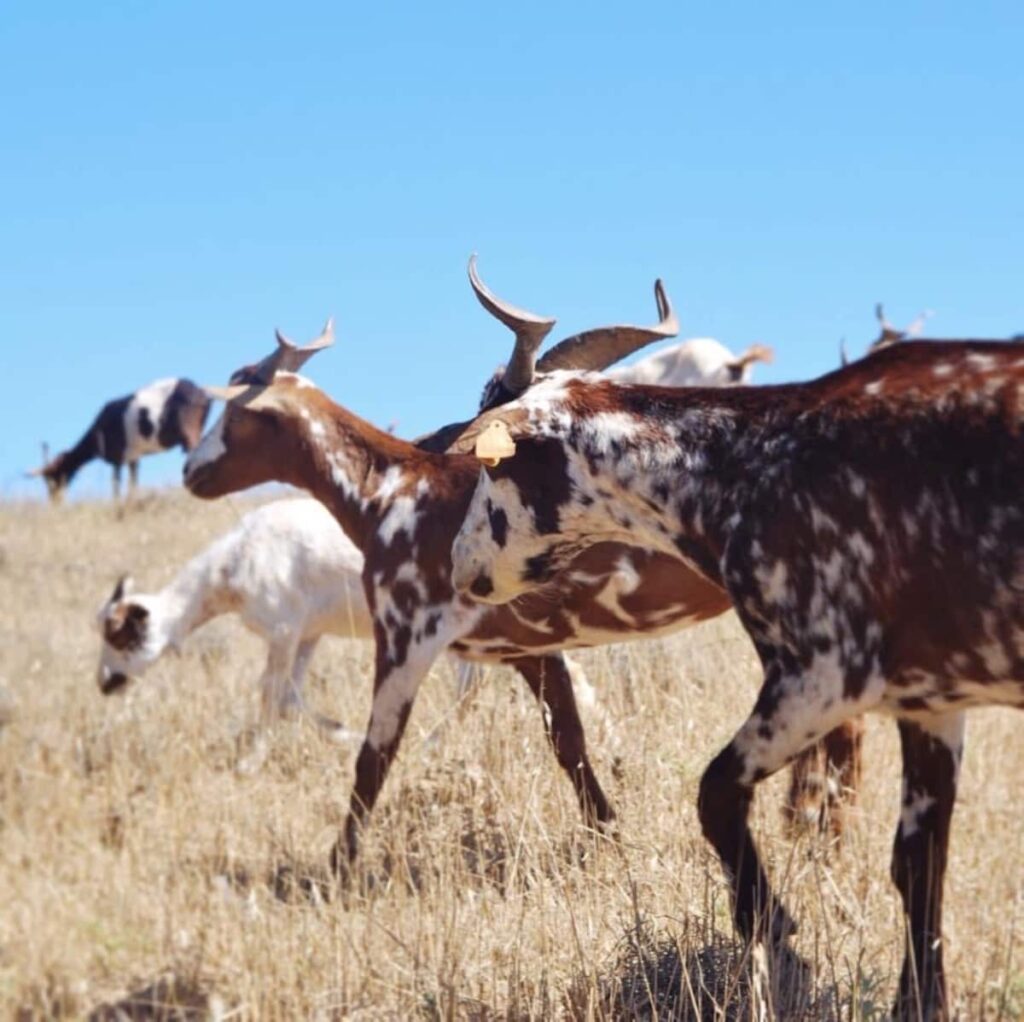The Afar goat, also known as the Adal and Danakil goat, is a unique breed that thrives in various regions of East Africa. Its natural habitat primarily lies within the Afar Region, but it can also be found in the northern and western Hararghe zones of the Oromia Region. Additionally, this resilient breed extends its distribution to Eritrea’s Afar area and parts of northern Djibouti. Known for their unique characteristics and versatility, the Afar goat has become increasingly popular in recent years.

All You Need to Know About Afar Goat Breed
Characteristics of the Afar Goat Breed
The average weight for Afar goat is about 45 kg (100 lbs). This breed’s weight makes it a suitable choice for those looking to raise goats primarily for meat production. Afar goats can provide a good amount of high-quality meat. In addition to their weight, these goats have other notable physical attributes.
They typically have short hair and well-developed muscles, contributing to their overall hardiness and adaptability in various climates. Another characteristic of the Afar goat is the breed’s reproductive abilities. Afar goats are known for being highly fertile and capable of producing multiple offspring per breeding season. This trait can be advantageous for farmers seeking to expand their herd quickly.
In addition to their resilience, these goats possess excellent foraging skills. They have been naturally selected for their browsing habits, enabling them to efficiently feed on a variety of plants including shrubs and trees. This versatility not only benefits the goats themselves but also reduces the need for supplementary feeding by farmers. The Afar goat breed displays good reproductive abilities.
Best Practices for Raising Afar Goats
Providing a suitable living environment is key. These goats thrive in arid and semi-arid regions, so they require access to ample grazing land with dry vegetation. Regular veterinary care is also important for maintaining the well-being of Afar goats. This includes routine vaccinations, deworming, and hoof trimming. To maximize meat production, it’s important to select breeding stock carefully. Look for healthy animals with desirable traits such as good body conformation and fast growth rates.
Breeding should be done at the appropriate age to ensure successful reproduction. Another important aspect of raising Afar goats is disease prevention. Implementing biosecurity measures, such as quarantining new animals before introducing them to the herd, can help prevent the spread of diseases. Regular monitoring of weight gain and overall health is necessary to identify any potential issues early on.
Nutritional Requirements and Feeding Strategies
Proper nutrition is important for the goat’s health and productivity. These hardy animals have specific nutritional needs that must ensure optimal growth and performance. Afar goats are primarily grazers, so their diet consists mainly of grasses, shrubs, and other vegetation found in their natural habitat. High-quality forage should make up the majority of an Afar goat’s diet. This includes fresh grasses and legumes such as alfalfa or clover.
Providing a diverse range of plants ensures that the goats receive a balanced mix of vitamins, minerals, and fiber. Feeding strategies should take into account the individual needs of each goat as well as available resources. It is important to monitor body condition regularly to ensure proper nutrition without overfeeding or underfeeding. Access to clean water is important for maintaining good overall health.
Breeding Afar Goats
Breeding Afar Goats is an essential aspect of raising this unique breed. When it comes to breeding, there are a few important factors to consider. Firstly, selecting the right breeding stock is crucial. Look for goats that exhibit desirable traits such as good body conformation, strong maternal instincts, and high milk production. It’s also important to ensure proper nutrition during the breeding process. Providing a good diet rich in vitamins and minerals will help optimize fertility rates and increase successful pregnancies.
When it comes to mating, take care to introduce the bucks at the appropriate time when the does are in heat. Monitoring the pregnancy’s progress is equally important. Health check-ups for goats can help detect any issues early on and allow for timely control if necessary. Breeding Afar Goats requires careful planning, attention to detail, and a commitment to ensuring their reproductive health.
Afar Goat Breed Care
To ensure successful care for your Afar goat herd, there are a few key factors to consider. Firstly, providing proper nutrition is essential. Afar goats have a high metabolism and require a diet rich in minerals, fiber, and protein. Regular health checks are also crucial when it comes to caring for Afar goats. Vaccinations against common diseases should be administered according to a veterinarian’s recommendations.
In case you missed it: Belgian Fawn Goats: How to Raise and Care

Housing plays a major role in the well-being of your Afar goats as well. They need shelter from extreme weather conditions such as excessive heat or cold temperatures. Proper hygiene practices must be followed in the management of your Afar goat herd. Regularly cleaning their living areas helps prevent the spread of diseases and parasites among the animals.
Common Diseases in Afar Goats
By implementing preventive measures, you can ensure the health and well-being of your herd. One common infectious disease that affects Afar goats is foot rot. This condition causes inflammation and infection in their hooves, leading to lameness if left untreated. To prevent foot rot, it’s important to maintain clean and dry living conditions for your goats.
Another disease that can impact Afar goats is pneumonia. Different factors, such as poor ventilation or extreme weather conditions, can cause this respiratory infection. Vaccinating your herd against pneumonia and providing them with proper shelter are effective ways to minimize its occurrence.
In addition to these diseases, several others, such as mastitis (inflammation of the udder), coccidiosis (intestinal infection), and contagious ecthyma (sore mouth), require attention when raising Afar goats. Regular monitoring of your herd’s health, early detection of symptoms, isolation of sick animals, when necessary, proper nutrition management, and maintaining good hygiene practices – all play vital roles in preventing common diseases among Afar goats.
Maximizing Meat and Milk Production in Afar Goats
These hardy animals have the potential to provide a significant source of income through their meat and milk yields. Providing a balanced diet that includes high-quality forage, grains, and supplements will help promote healthy growth and increase the animal’s ability to produce quality meat and milk. Maintaining good herd management practices is crucial. Regular health check-ups by a veterinarian can help identify any issues early on before they become major problems.
Vaccinations should be administered as recommended to prevent common diseases that could negatively impact productivity. Another important factor in maximizing meat production in Afar goats is providing adequate housing and shelter for the goats. A clean, comfortable environment reduces stress levels, which can affect productivity. Regular monitoring of weight gain or milk yield will enable you to adjust feeding strategies if necessary.
Integrating Afar Goats into Sustainable Farming Systems
When it comes to goats, the Afar breed offers a great opportunity for farmers looking to enhance their farming systems. Afar goats are well-suited for integration due to their adaptability and resilience in harsh environments. These goats have a unique browsing behavior that allows them to feed on various vegetation, including shrubs and thorny bushes. This makes them excellent natural weed control agents in grazing areas. Afar goats can efficiently convert low-quality forage into valuable products such as meat and milk.
When integrated into sustainable farming systems, these oats can contribute significantly towards soil fertility improvement through their manure production. Moreover, integrating Afar goats into rotational grazing systems helps prevent overgrazing by allowing pastures time to regenerate naturally. This practice promotes biodiversity and ensures the long-term sustainability of both animal and plant species in the ecosystem.
In case you missed it: Utilizing Goats for Weed Control in Pastures and Woodlands

Conclusion
The Afar Goat Breed offers numerous benefits to farmers and livestock owners. The key advantage is their adaptability to harsh environments. These goats are well-suited for arid regions, where they can thrive despite limited access to water and vegetation. Raising Afar goats requires careful attention to their specific needs and well-being. These goats are hardy, adaptable, and can thrive in harsh environments.
Note: The images presented in this post are intended solely for representation purposes. The images are meant to serve as visual aids and should not be relied upon as accurate representations of their real-life counterparts.
- Types of Grass Growing for Goat Farm
- How to Train Goats for Milking: A Beginners Guide
- Goat Milking Practices and Equipment: A Beginner’s Guide
- Goat Farming for Fiber: Producing Mohair and Cashmere
- Maximizing Goat Milk Production: Tips for Dairy Goat Farmers
- Goat Farming as a Family Business: Strategies for Success
- Profitable Kenya Goat Breeds for Commercial Dairy and Meat Business
- Unlock the Secrets of Oberhasli Goat: Discover Raising and Management Practices
- Ultimate Guide to Myotonic Goats: Explore Profile to Raising